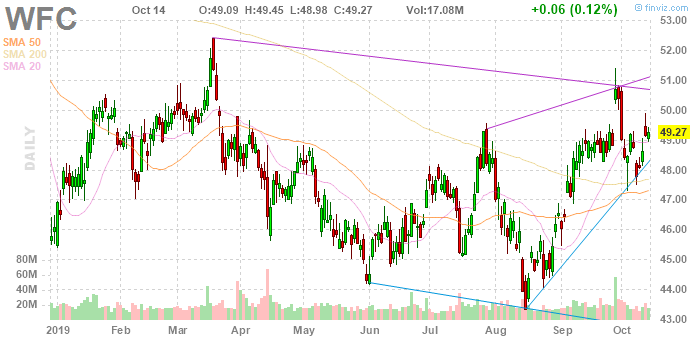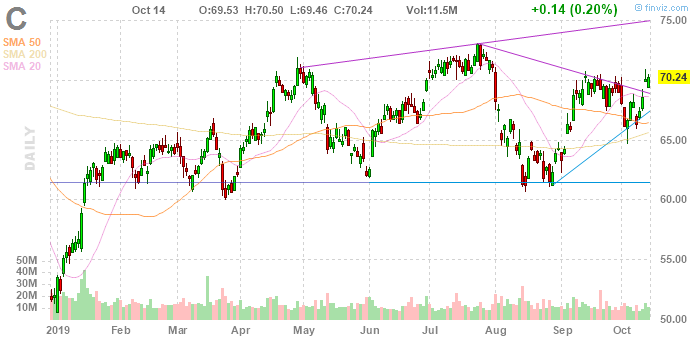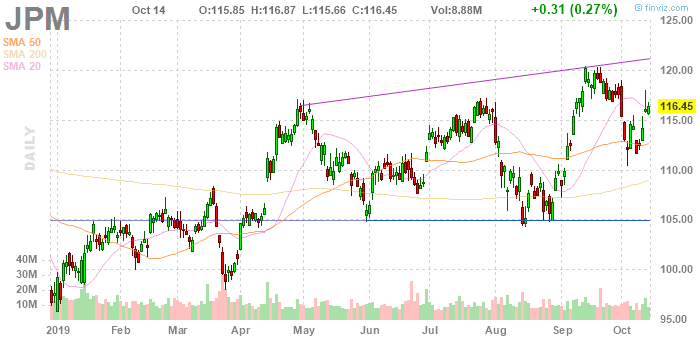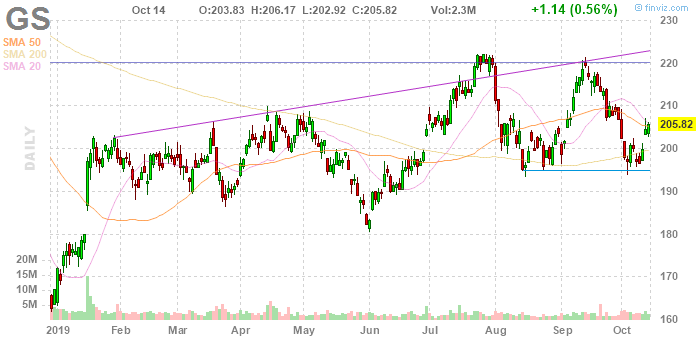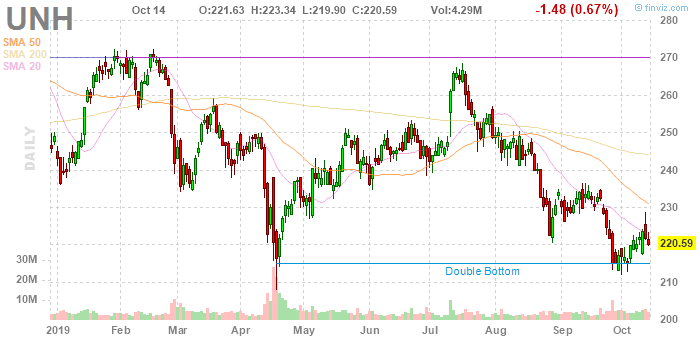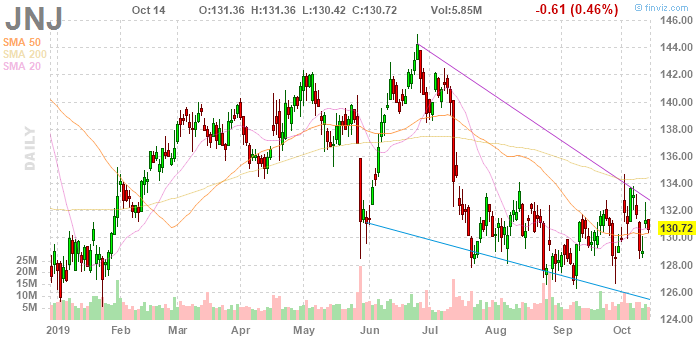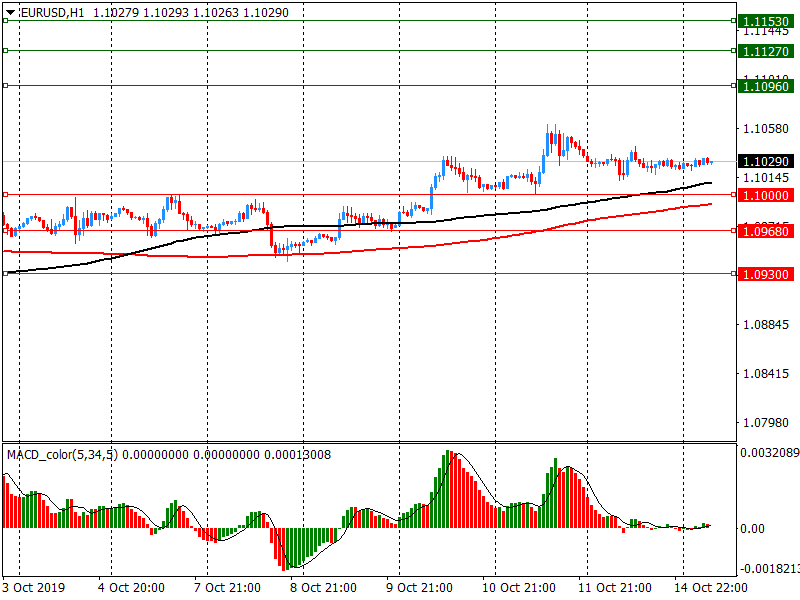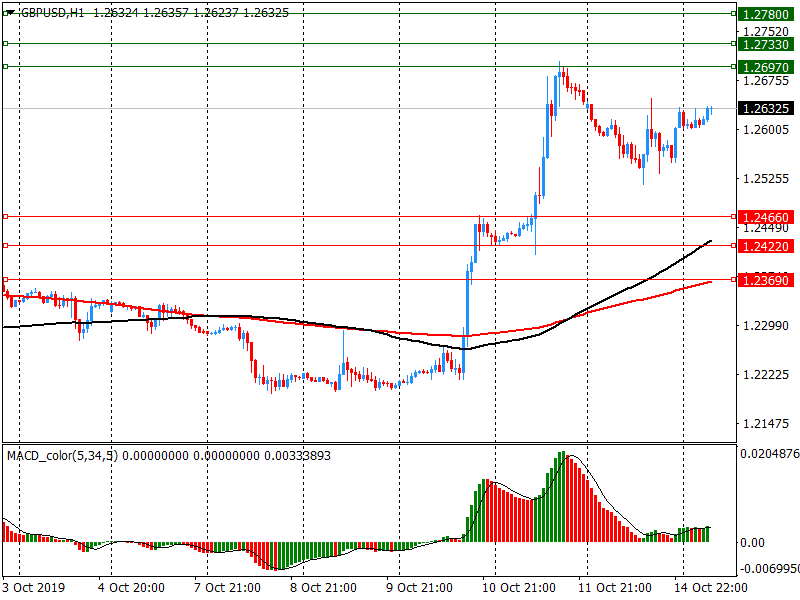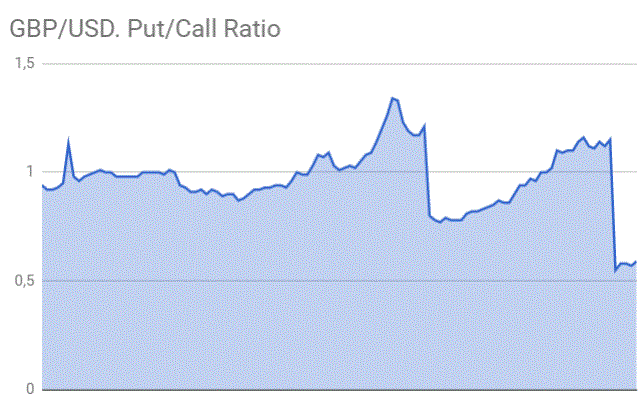- Analiza
- Novosti i instrumenti
- Vesti sa tržišta
Forex-novosti i prognoze od 15-10-2019
| Time | Country | Event | Period | Previous value | Forecast |
|---|---|---|---|---|---|
| 08:30 | United Kingdom | Producer Price Index - Output (MoM) | September | -0.1% | 0.1% |
| 08:30 | United Kingdom | Producer Price Index - Input (MoM) | September | -0.1% | 0.2% |
| 08:30 | United Kingdom | Producer Price Index - Input (YoY) | September | -0.8% | -1.8% |
| 08:30 | United Kingdom | Producer Price Index - Output (YoY) | September | 1.6% | 1.3% |
| 08:30 | United Kingdom | Retail Price Index, m/m | September | 0.8% | -0.1% |
| 08:30 | United Kingdom | HICP ex EFAT, Y/Y | September | 1.5% | 1.7% |
| 08:30 | United Kingdom | Retail prices, Y/Y | September | 2.6% | 2.6% |
| 08:30 | United Kingdom | HICP, m/m | September | 0.4% | 0.2% |
| 08:30 | United Kingdom | HICP, Y/Y | September | 1.7% | 1.8% |
| 09:00 | Eurozone | Trade balance unadjusted | August | 24.8 | 17.5 |
| 09:00 | Eurozone | Harmonized CPI ex EFAT, Y/Y | September | 0.9% | 1% |
| 09:00 | Eurozone | Harmonized CPI | September | 0.1% | 0.2% |
| 09:00 | Eurozone | Harmonized CPI, Y/Y | September | 1% | 0.9% |
| 12:30 | Canada | Foreign Securities Purchases | August | -1.17 | |
| 12:30 | U.S. | Retail Sales YoY | September | 4.1% | |
| 12:30 | U.S. | Retail sales excluding auto | September | 0% | 0.2% |
| 12:30 | U.S. | Retail sales | September | 0.4% | 0.3% |
| 12:30 | Canada | Bank of Canada Consumer Price Index Core, y/y | September | 1.9% | 1.9% |
| 12:30 | Canada | Consumer Price Index m / m | September | -0.1% | -0.2% |
| 12:30 | Canada | Consumer price index, y/y | September | 1.9% | 2.1% |
| 13:00 | U.S. | FOMC Member Charles Evans Speaks | |||
| 14:00 | U.S. | NAHB Housing Market Index | October | 68 | 68 |
| 14:00 | U.S. | Business inventories | August | 0.4% | 0.2% |
| 17:00 | Germany | German Buba President Weidmann Speaks | |||
| 18:00 | U.S. | Fed's Beige Book | |||
| 19:00 | U.S. | FOMC Member Brainard Speaks | |||
| 20:00 | U.S. | Net Long-term TIC Flows | August | 84.3 | 23.1 |
| 20:00 | U.S. | Total Net TIC Flows | August | 43.8 | 66.6 |
| 22:15 | Australia | RBA Assist Gov Debelle Speaks |
U.S. major stock indexes rose significantly, as the published solid quarterly results of UnitedHealth (UNH), Johnson & Johnson (JNJ) and JPMorgan Chase (JPM) eased concerns about the negative impact of the protracted US-China trade war on US companies.
UnitedHealth announced that it received a adjusted quarterly profit of $ 3.88 per share, which was higher than the average forecast of analysts at $ 3.76. The company's revenue also exceeded market expectations and it raised its profit forecast for the whole of 2019. UNH shares soared 8.31%.
Johnson & Johnson reported quarterly earnings of $ 2.12 per share, compared with analysts' average forecast of $ 2.01. The quarterly revenue of the manufacturer of medical equipment and consumer goods also exceeded the average market estimate, which was mainly facilitated by the growth in sales of medicines and medical devices. JNJ shares jumped 1.62%.
JPMorgan Chase reported quarterly earnings of $ 2.68 per share, which was $ 0.22 higher than analysts' average forecast. The financial institution’s revenues also exceeded Wall Street’s forecasts, driven by growth in mortgages, car loans and credit cards. JPM shares rose 3.17%.
According to CNBC, of the 34 companies in the S&P 500 index that have already posted third-quarter results, 29 have exceeded expectations. However, it is worth noting that, in general, expectations for the reporting season are quite pessimistic: analysts polled by FactSet predict that the profit of the S&P 500 index will show a decrease of 4.6% compared to the same period last year.
Most DOW components completed trading in positive territory (25 out of 30). The biggest gainers were UnitedHealth Group Inc. (UNH .; + 8.31%). Outsider were the shares of The Procter & Gamble Co. (PG; -2.34%).
Most S&P sectors recorded an increase. The health sector grew the most (+ 1.8%). The conglomerate sector showed the largest decrease (-0.2%).
At the time of closing:
Dow 27,025.00 +237.64 +0.89%
S&P 500 2,995.64 +29.49 +0.99%
Nasdaq 100 8,148.71 +100.06 +1.24%
| Time | Country | Event | Period | Previous value | Forecast |
|---|---|---|---|---|---|
| 08:30 | United Kingdom | Producer Price Index - Output (MoM) | September | -0.1% | 0.1% |
| 08:30 | United Kingdom | Producer Price Index - Input (MoM) | September | -0.1% | 0.2% |
| 08:30 | United Kingdom | Producer Price Index - Input (YoY) | September | -0.8% | -1.8% |
| 08:30 | United Kingdom | Producer Price Index - Output (YoY) | September | 1.6% | 1.3% |
| 08:30 | United Kingdom | Retail Price Index, m/m | September | 0.8% | -0.1% |
| 08:30 | United Kingdom | HICP ex EFAT, Y/Y | September | 1.5% | 1.7% |
| 08:30 | United Kingdom | Retail prices, Y/Y | September | 2.6% | 2.6% |
| 08:30 | United Kingdom | HICP, m/m | September | 0.4% | 0.2% |
| 08:30 | United Kingdom | HICP, Y/Y | September | 1.7% | 1.8% |
| 09:00 | Eurozone | Trade balance unadjusted | August | 24.8 | 17.5 |
| 09:00 | Eurozone | Harmonized CPI ex EFAT, Y/Y | September | 0.9% | 1% |
| 09:00 | Eurozone | Harmonized CPI | September | 0.1% | 0.2% |
| 09:00 | Eurozone | Harmonized CPI, Y/Y | September | 1% | 0.9% |
| 12:30 | Canada | Foreign Securities Purchases | August | -1.17 | |
| 12:30 | U.S. | Retail Sales YoY | September | 4.1% | |
| 12:30 | U.S. | Retail sales excluding auto | September | 0% | 0.2% |
| 12:30 | U.S. | Retail sales | September | 0.4% | 0.3% |
| 12:30 | Canada | Bank of Canada Consumer Price Index Core, y/y | September | 1.9% | 1.9% |
| 12:30 | Canada | Consumer Price Index m / m | September | -0.1% | -0.2% |
| 12:30 | Canada | Consumer price index, y/y | September | 1.9% | 2.1% |
| 13:00 | U.S. | FOMC Member Charles Evans Speaks | |||
| 14:00 | U.S. | NAHB Housing Market Index | October | 68 | 68 |
| 14:00 | U.S. | Business inventories | August | 0.4% | 0.2% |
| 17:00 | Germany | German Buba President Weidmann Speaks | |||
| 18:00 | U.S. | Fed's Beige Book | |||
| 19:00 | U.S. | FOMC Member Brainard Speaks | |||
| 20:00 | U.S. | Net Long-term TIC Flows | August | 84.3 | 23.1 |
| 20:00 | U.S. | Total Net TIC Flows | August | 43.8 | 66.6 |
| 22:15 | Australia | RBA Assist Gov Debelle Speaks |
- We will stick to balanced-budget rule of no new debt for now
- It would be good if there was a last-minute agreement on Brexit
- No-deal Brexit would damage Britain the most, but it would also impact everybody
- Draft deal is dependent on getting support from the DUP
Iris Pang, the economist for Greater China at ING, notes that M2, a widely-used gauge of credit expansion, increased to 8.4% year on year in September from 8.2% a month ago.
- "Renminbi loans grew by CNY 13.9 trillion in the third quarter, which is equivalent to around 14.5% of nominal GDP for the four quarters from 3Q18 to 2Q19.
- Of all the items, the most eye-catching is the CNY 2 trillion increase in local government special bonds in the third quarter used to finance infrastructure projects. The quota for these bonds was only CNY 2 trillion, with this entire amount used in 3Q alone.
- The substantial increase in local government bonds suggests that the economy has relied on infrastructure investments to support GDP growth.
- We expect there will be another CNY 1 trillion increase in local government special bonds in the fourth-quarter, with the central government having allowed local governments to borrow next year's issuance quota.
- This is why we think China will continue to accumulate debt until the US-China trade war ends and during this time infrastructure investments will continue to be the main pillar of economic growth."
- This marks the lowest growth estimate since the 2008/09 global financial crisis
- Lowers 2020 growth forecast to 3.4% from 3.5%
- Cuts 2019 U.S. growth forecast to 2.4% from 2.6%
- Increases 2020 U.S. growth forecast to 2.1% from 1.9%
- Cuts 2019 China growth forecast to 6.1% from 6.2%
- Cuts 2020 China growth forecast to 5.8% from 6.0%
- Estimates U.S.-China trade tensions will cumulatively reduce global growth by 0.8% by 2020
- Says risks skewed to the downside due to uncertainty over trade tensions, Brexit, declines in risk appetite and manufacturing weakness
U.S. stock-index futures rose on Tuesday, as the Q3 earnings season started on a positive note due to solid reports from UnitedHealth (UNH), Johnson & Johnson (JNJ) and JPMorgan Chase (JPM).
Global Stocks:
Index/commodity | Last | Today's Change, points | Today's Change, % |
Nikkei | 22,207.21 | +408.34 | +1.87% |
Hang Seng | 26,503.93 | -17.92 | -0.07% |
Shanghai | 2,991.05 | -16.84 | -0.56% |
S&P/ASX | 6,652.00 | +9.40 | +0.14% |
FTSE | 7,184.66 | -28.79 | -0.40% |
CAC | 5,670.51 | +27.43 | +0.49% |
DAX | 12,538.76 | +52.20 | +0.42% |
Crude oil | $53.51 | -0.15% | |
Gold | $1,496.70 | -0.06% |
Analysts at TD Securities note this morning's UK labour market report was disappointing, with the unemployment rate unexpectedly rising to 3.9% (mkt 3.8%).
- “Headline wage growth also slowed unexpectedly to 3.8% y/y (mkt 4.0%), although underlying wage growth is still looking solid, with private sector regular pay sitting at 4.0% y/y for the third month in a row, and with a 3m/3m annualiяed rate of over 5%.
- So overall wage growth wasn't too bad, but the jobs numbers themselves were softer, with employment at -56K on a 3m/3m basis, its worst print since May 2015. If the PMIs are any indication, then we expect to see the jobs data soften further in the coming months.”
(company / ticker / price / change ($/%) / volume)
3M Co | MMM | 160 | -0.51(-0.32%) | 2707 |
ALTRIA GROUP INC. | MO | 42.8 | 0.08(0.19%) | 6195 |
Amazon.com Inc., NASDAQ | AMZN | 1,741.62 | 5.19(0.30%) | 10942 |
American Express Co | AXP | 117 | 0.61(0.52%) | 2027 |
Apple Inc. | AAPL | 236.57 | 0.70(0.30%) | 127365 |
AT&T Inc | T | 37.5 | 0.03(0.08%) | 16069 |
Boeing Co | BA | 372 | -1.18(-0.32%) | 1280 |
Caterpillar Inc | CAT | 128.55 | 0.17(0.13%) | 2791 |
Chevron Corp | CVX | 116.35 | 0.17(0.15%) | 902 |
Cisco Systems Inc | CSCO | 46.19 | 0.14(0.30%) | 6340 |
Citigroup Inc., NYSE | C | 69.7 | -0.54(-0.77%) | 274787 |
E. I. du Pont de Nemours and Co | DD | 64.47 | -0.33(-0.51%) | 5083 |
Facebook, Inc. | FB | 183.87 | 0.59(0.32%) | 24239 |
FedEx Corporation, NYSE | FDX | 147.01 | 0.23(0.16%) | 1549 |
Ford Motor Co. | F | 8.85 | 0.03(0.34%) | 1439 |
General Electric Co | GE | 8.73 | 0.01(0.11%) | 48883 |
General Motors Company, NYSE | GM | 35.73 | 0.23(0.65%) | 706 |
Goldman Sachs | GS | 201.5 | -4.32(-2.10%) | 122203 |
Google Inc. | GOOG | 1,222.99 | 5.85(0.48%) | 2366 |
Hewlett-Packard Co. | HPQ | 16.6 | 0.06(0.36%) | 6740 |
Home Depot Inc | HD | 234.67 | 0.49(0.21%) | 2133 |
Intel Corp | INTC | 52 | 0.36(0.70%) | 19549 |
International Business Machines Co... | IBM | 141.98 | -0.06(-0.04%) | 1997 |
Johnson & Johnson | JNJ | 132.9 | 2.18(1.67%) | 112325 |
JPMorgan Chase and Co | JPM | 118.71 | 2.26(1.94%) | 351043 |
McDonald's Corp | MCD | 209 | 0.62(0.30%) | 1895 |
Merck & Co Inc | MRK | 85.2 | 0.51(0.60%) | 204 |
Microsoft Corp | MSFT | 140 | 0.45(0.32%) | 25553 |
Nike | NKE | 95.2 | 0.32(0.34%) | 1899 |
Pfizer Inc | PFE | 36.35 | 0.05(0.14%) | 8085 |
Procter & Gamble Co | PG | 120.25 | 0.20(0.17%) | 2016 |
Starbucks Corporation, NASDAQ | SBUX | 86.99 | 0.37(0.43%) | 4513 |
Tesla Motors, Inc., NASDAQ | TSLA | 257.48 | 0.52(0.20%) | 52693 |
The Coca-Cola Co | KO | 53.4 | 0.10(0.19%) | 1464 |
Twitter, Inc., NYSE | TWTR | 39.56 | -0.22(-0.55%) | 29303 |
UnitedHealth Group Inc | UNH | 225.4 | 4.81(2.18%) | 59132 |
Verizon Communications Inc | VZ | 59.7 | 0.10(0.17%) | 1866 |
Visa | V | 178 | 0.64(0.36%) | 2427 |
Wal-Mart Stores Inc | WMT | 119.38 | 0.21(0.18%) | 1472 |
Walt Disney Co | DIS | 130.1 | 0.40(0.31%) | 3732 |
Yandex N.V., NASDAQ | YNDX | 31 | 0.70(2.31%) | 51321 |
- Stimulus needed if Brexit uncertainty becomes entrenched
- Global outlook has deteriorated since July
- Sees risk of monetary policy running out of ammunition
- Scenario of entrenched Brexit uncertainty is likely to require stimulus
NVIDIA (NVDA) target raised to $250 from $225 at BofA/Merrill
Richard Franulovich, the head of FX strategy at Westpac, notes that a sectoral breakdown of the U.S. data surprises.
- “The preponderance of downside US data surprises are coming from the “business sector”, understandable given weakening global activity and related to that, elevated trade uncertainty, are transmitted primarily through corporate sector.
- Leading indicators suggest these prevailing divergent sectoral trends will intensify in coming months.
- The business sector likely continues to struggle.
- The weakness in labour demand indicators may prove to be an overshoot but taken at face value we may be on the cusp of a notably negative run of surprises.
- Historically there’s not much difference to the USD’s performance in the first few months of either an insurance easing cycle or a more notable easing cycle – the DXY tends to be resilient regardless. But, if the Fed goes beyond a “mid-cycle” adjustment and embarks on a genuine easing cycle the USD eventually capitulates, notching up an average 6%+ decline 9-12 months into the cycle. On the other hand if this proves to be a short series of insurance cuts such as 1995 and 1998 the DXY could find itself substantially higher in a few months.”
Wells Fargo (WFC) reported Q3 FY 2019 earnings of $0.92 per share (versus $1.13 in Q3 FY 2018), missing analysts’ consensus estimate of $1.18.
The company’s quarterly revenues amounted to $22.010 bln (+0.3% y/y), beating analysts’ consensus estimate of $21.320 bln.
WFC fell to $49.15 (-0.24%) in pre-market trading.
Citigroup (C) reported Q3 FY 2019 earnings of $1.97 per share (versus $1.73 in Q3 FY 2018), beating analysts’ consensus estimate of $1.95.
The company’s quarterly revenues amounted to $18.574 bln (+1.0% y/y), generally in line with analysts’ consensus estimate of $18.545 bln.
C fell to $69.88 (-0.51%) in pre-market trading.
JP Morgan Chase (JPM) reported Q3 FY 2019 earnings of $2.68 per share (versus $2.34 in Q3 FY 2018), beating analysts’ consensus estimate of $2.46.
The company’s quarterly revenues amounted to $29.341 bln (+7.6% y/y), beating analysts’ consensus estimate of $28.363 bln.
JPM rose to $118.80 (+2.02%) in pre-market trading.
Goldman Sachs (GS) reported Q3 FY 2019 earnings of $4.79 per share (versus $6.28 in Q3 FY 2018), missing analysts’ consensus estimate of $4.89.
The company’s quarterly revenues amounted to $8.320 bln (-3.8% y/y), generally in line with analysts’ consensus estimate of $8.326 bln.
GS fell to $204.00 (-0.88%) in pre-market trading.
FX Strategists at UOB Group believe the upside momentum in USD/JPY could see the 109.00-region re-visited in the near term.
- "24-hour view: USD traded between 108.02 and 108.52 yesterday, narrower than our expected sideway-trading range of 108.00/108.60. The price action is viewed as an on-going consolidation phase. That said, the underlying tone has firmed somewhat and USD is likely to trade at a higher trading range of 108.10/108.65.
- Next 1-3 weeks: We indicated last Friday (11 Oct, spot at 107.85) that the top of our expected sideway trading range at 108.50 “is more vulnerable” and added, “a break of this strong level could sent USD to 109.00”. However, the rapid manner by which USD cracked 108.50 was not exactly expected (USD touched 108.61 during NY hours on Friday). While the advance appears to be running ahead of itself, the risk is for further USD strength to 109.00. Only a break of 107.50 would suggest the current upward pressure has eased."
UnitedHealth Group (UNH) reported Q3 FY 2019 earnings of $3.88 per share (versus $3.41 in Q3 FY 2018), beating analysts’ consensus estimate of $3.76.
The company’s quarterly revenues amounted to $60.351 bln (+6.7% y/y), generally in line with analysts’ consensus estimate of $59.836 bln.
The company also raised its FY 2019 EPS guidance to $14.90-15.00, up from $14.70-14.90 prior, versus analysts’ consensus estimate of $14.83.
UNH rose to $225.70 (+2.32%) in pre-market trading.
Johnson & Johnson (JNJ) reported Q3 FY 2019 earnings of $2.12 per share (versus $2.05 in Q3 FY 2018), beating analysts’ consensus estimate of $2.01.
The company’s quarterly revenues amounted to $20.729 bln (+1.9% y/y), beating analysts’ consensus estimate of $20.142 bln.
The company also raised guidance for FY 2019, projecting EPS of $8.62-8.67 (versus its prior guidance of $8.53-8.63 and analysts’ consensus estimate of $8.61) and revenues of $81.8-82.3 bln (versus its prior guidance of $80.8-81.6 bln and analysts’ consensus estimate of $81.59 bln).
JNJ rose to $133.28 (+1.96%) in pre-market trading.
Analysts at ABN AMRO note the escalation of trade/tech tensions between the U.S. and China since early 2018 has been a key headwind for global growth.
- “After a re-escalation of US-China tensions since May 2019 – with new tariffs introduced, existing tariffs raised and all kinds of non-tariff measures taken as well – we have seen over the past month some goodwill gestures by both sides suggesting a potential shift in political calculus in both Washington and Beijing. This latest development follows that trend – with hostilities seemingly on hold rather than definitively ending.
- The preliminary agreement entails the US from refraining from a scheduled – previously postponed – tariff hike per 15 October (from 25% to 30% on USD 250bn of imports from China) in exchange for China further stepping up agricultural imports from the US. Crucially, the 15% on the remaining $175bn of imports yet to be tariffed (scheduled for 15 December) remains on the table as negotiating leverage.
- Moreover, the US and China will work on an agreement on exchange rate policies and the protection of intellectual property. While the announcement of this partial deal was welcomed by financial markets and it reduces downside risks somewhat, it does little by itself to change the macro scenario, with businesses likely having built in persistent uncertainty to trade policy into their baseline outlooks.
- We remain comfortable with our below-consensus growth forecasts. Even if a more definitive deal is reached in November, we think that strategic tensions, particularly on the technology front, will linger.”
October 15
Before the Open:
Citigroup (C). Consensus EPS $1.95, Consensus Revenues $18544.78 mln
Goldman Sachs (GS). Consensus EPS $4.89, Consensus Revenues $8326.06 mln
Johnson & Johnson (JNJ). Consensus EPS $2.01, Consensus Revenues $20142.05 mln
JPMorgan Chase (JPM). Consensus EPS $2.46, Consensus Revenues $28362.87 mln
UnitedHealth (UNH). Consensus EPS $3.76, Consensus Revenues $59836.36 mln
Wells Fargo (WFC). Consensus EPS $1.18, Consensus Revenues $21319.50 mln
October 16
Before the Open:
Bank of America (BAC). Consensus EPS $0.68, Consensus Revenues $22729.68 mln
After the Close:
Alcoa (AA). Consensus EPS -$0.28, Consensus Revenues $2581.98 mln
IBM (IBM). Consensus EPS $2.66, Consensus Revenues $18292.87 mln
Netflix (NFLX). Consensus EPS $1.05, Consensus Revenues $5247.81 mln
October 17
Before the Open:
Honeywell (HON). Consensus EPS $2.01, Consensus Revenues $9145.67 mln
Morgan Stanley (MS). Consensus EPS $1.12, Consensus Revenues $9626.70 mln
October 18
Before the Open:
American Express (AXP). Consensus EPS $2.03, Consensus Revenues $10946.06 mln
Coca-Cola (KO). Consensus EPS $0.56, Consensus Revenues $9441.28 mln
FX Strategists at UOB Group still believe the GBP/USD could advance well above the 1.2700 handle in the next weeks.
- "24-hour view: We highlighted yesterday that “the risk is for a pull-back in GBP but any weakness is viewed as part of lower trading range of 1.2480/1.2680”. GBP subsequently dipped to 1.2517 before rebounding back up to 1.2650. The price action is still viewed as part of consolidation phase even though the firmed underlying tone suggests GBP is likely to trade sideways at a higher range of 1.2550/1.2680.
- Next 1-3 weeks: We held the view last Friday “the price action has clearly shifted the risk to the upside”. However, we woefully underestimated the pace of GBP’s strength as it blew past “the several strong resistance levels that are stacked close to each other” and rocketed to a high of 1.2708 before ending last Friday at 1.2650 (for a 1-week gain of +2.57%, the largest in more than 2 years). From here, GBP is likely ‘attracted’ by the June’s top of 1.2784 but severely overbought short-term conditions could lead to a couple of days of consolidation first. That said, the declining weekly trend line resistance connecting 1.4377 (Apr 2018) and 1.3380 (Mar 2019) currently sits at 1.2720 and this level may temporarily thwart the advance in GBP (trend line not visible in chart below but can be seen in our Quarterly Global Outlook from last month). All in, the risk is still for a higher GBP and only a break of 1.2380 (‘strong support’ level at 1.2300 last Friday) would indicate the current positive phase has run its course."
- Says PM is aware of the time constraints
- Confirms that PM spoke to France's President Macron on Tuesday morning and said that their call was constructive
- Says zero rates, forward guidance, QE still in the playbook for "ordinary recession"
- Says Fed repo facility is a sensible endgame to control rates
- Defends that bill purchases are "definitely not" QE
- Says that must consider additional rate cut insurance but he does not want to pre-judge the next Fed meeting
- Adds he is not a fan of negative interest rates
- Decisions on future cuts will be meeting-by-meeting
- Says trade policy uncertainty factors into calculation
- Recent yield curve inversion was a warning sign
- Sees risk of inflation staying too low
- Sees risk of sharper-than-expected economic slowdown
- Could reverse rate cuts in 2020, 2021 if economy improves again
- We are likely to continue to stay in a low-interest-rate environment
- Banks in the United Kingdom have enough capital to deal with a no-deal Brexit and an intensified trade war between the United States and China
- Rate cuts will be passed on to households via banking system
Ho Woei Chen, Economist at UOB Group, assessed the recent trade data from the Chinese economy and prospects for economic growth.
“China’s exports (in USD terms) remained in contraction at -3.2% y/y in Sep (exp: -2.8%, Aug: - 1.0%) and imports at -8.5% in Sep (exp: -6.0%, Aug: -5.6%), coming in below consensus expectation. Trade surplus widened to US$39.65 bn in Sep from US$34.83 bn in Aug. Although US and China reached a Phase 1 trade deal, there was no major breakthroughs and the bulk of the focus was on the US$40-50 bn in annual agricultural goods purchases by China while the the 15 Oct tariff was delayed not cancelled and 15 Dec US additional tariffs of 15% on approximately US$160 of Chinese goods remains in place. Between now and APEC summit on 16-17 Nov where US and China leaders will sign the Phase 1 agreement, there remains significant risk of breakdown in talks. We assessed the probability to be around 35%. With existing tariffs remaining in place, we keep our full-year growth forecast for China at 6.1% in 2019 and 5.9% in 2020. We expect to see continued weakness in China’s economic data in the near-term. This includes the upcoming release of the 3Q19 GDP (18 Oct), which we forecast at 6.0% y/y vs. 6.2% in 2Q19. This should see Chinese policymakers maintaining a measured pace of proactive fiscal and monetary easing”.
China's central bank said on Tuesday that demand from the real economy for credit remains relatively strong and credit support for the real economy is increasing.
The comments, made by Ruan Jianhong, head of the central bank's statistics department, came after official data showed China's banks extended more new yuan loans than expected in September as policymakers ramped up efforts to stabilise the cooling economy as U.S. trade pressures build.
Medium and long-term corporate loans were picking up, while property loan growth was slowing, Ruan told reporters at a press conference, adding that the central bank would guide financial institutions to step up lending support for small firms.
Rabobank analysts suggest that this week’s soft activity data from China provides the backdrop to the semi-annual meeting of the IMF which starts in Washington today.
“The latest IMF World Economic report is expected to contain a downward revision to growth projections as indicated last week by incoming Head Kristalina Georgieva. Her remark that “the widespread deceleration means that growth this year will fall to its lowest rate since the beginning of the decade,” likely suggests a downward revision to growth forecasts for both this year and next. The debate about whether governments should be loosening their purse strings to support ailing growth and to complement accommodative monetary policies could be given an airing during this week’s meetings.”
According to the report from Leibniz Centre for European Economic Research (ZEW), indicator of economic sentiment for Germany recorded a very slight decrease of 0.3 points in October 2019, and now stands at -22.8 points. Economists had expected a decline to -27. It thus remains well below the long-term average of 21.4 points. In the current October survey, the assessment of the economic situation in Germany worsened again, by 5.4 points, with the corresponding indicator falling to a current reading of -25.3 points. This has been the lowest reading since April 2010
“The slight decrease in both the ZEW Indicator of Economic Sentiment and the situation indicator shows that financial market experts continue to expect a further deterioration of the German economy. The recent settlement in the trade dispute between the USA and China does not seem to diminish economic scepticism at this stage,” comments ZEW President Professor Achim Wambach.
The financial market experts’ sentiment concerning the economic development of the eurozone also experienced a decrease, with the corresponding indicator falling 1.1 points to a current level of -23.5 points compared to the previous month. The indicator for the current economic situation in the eurozone dropped quite sharply by 10.8 points to a new level of -26.4 points. Expectations of the inflation trend in the eurozone are also declining considerably. In the current survey, the inflation indicator fell by 8.5 points to 1.0 points.
According to the report from Office for National Statistics, the UK employment rate was estimated at 75.9%, higher than a year earlier (75.6%) but 0.2 percentage points lower than the previous quarter.
the estimated employment rate for men was 80.2%; this is largely unchanged on the year and on the quarter
the estimated employment rate for women was 71.6%; this is 0.6 percentage points up on the year, but 0.3 percentage points down on the quarter
The UK unemployment rate was estimated at 3.9%, this is lower than a year earlier (4.0%) but 0.1 percentage points higher than the previous quarter. Unemployment was expected to remain at 3.9%.
The UK economic inactivity rate was estimated at 21.0%, this is lower than a year earlier (21.2%) but 0.1 percentage points higher on the previous quarter.
Estimated annual growth in average weekly earnings for employees in Great Britain was 3.8% for both total pay (including bonuses) and regular pay (excluding bonuses). Economists had expected a 3.7% increase.
In real terms (after adjusting for inflation), annual growth in total pay was estimated to be 1.9% and annual growth in regular pay was estimated to be 2.0%.
According to analysts at TD Securities, August may see one of the final gasps of strength for the UK’s labour market, as they are looking for the unemployment rate to fall to a new multi-decade low of 3.7% (mkt 3.8%).
“We do look for the strength in job growth to slow in the coming months; the one consistent message from all three UK PMIs for September was that employment has started contracting across all sectors of the economy. For wage growth, we look for headline wages to hold steady at 4.0% y/y, and ex-bonus wages to also come in unchanged at 3.8% y/y. Wage growth is likely to remain elevated for a while, as they tend to follow growth and labour market trends only with a lag.”
The United States is just one bad recession away from being right back at zero interest rates or even lower, Larry Summers warned on CNBC.
“It’s a very different world when everyone’s stuck at zero interest rates,” said Summers, a critic of President Donald Trump who served as former President Bill Clinton’s Treasury secretary and as an economic advisor for former President Barack Obama.
“We’ll have to think about stabilization policy. Institutions are going to have to think about their investment policy in a very different world when we have a black hole, zero interest rate world,” Summers said.
“I fear that’s what we’re headed into,” the Harvard economics professor warned, pointing to Japan’s economy, which has experienced decades of stagnation. The Japanese central bank, the Bank of Japan, embarked on its journey into negative rates in 2016, about two years after the European Central Bank.
Without major change in the U.S., Summers predicts there’s little chance of policy rates set by the Federal Reserve staying above zero. “We’re one recession away from a situation of that kind.”
Summers said he sees a recession on the horizon but put the risk of it happening next year below 50%. Those odds go up over the next several years, he added.
Danske Bank analysts suggest that politics remain in the spotlight, not least with the Brexit negotiations moving into the final hours before the EU summit on Thursday-Friday.
“As time is short, we remain sceptical that a deal will be reached and even if that is the case, we do not expect a majority in the House of Commons to support it,. Also, markets will continue to monitor the trade negotiations closely, after China made it clear yesterday that it is less optimistic than the US. IMF's annual meeting starts today with the release of the new world economic outlook. Many central bank officials are set to speak in the coming days, both from the Fed and the ECB, as both central banks enter the official silence period later this week. The ZEW survey is due for release today. It will be interesting to see whether the rebound in expectations and the fall in the current situation continue. The UK labour market report for August is due out as well. Employment has continued to increase at a decent pace despite slower growth and weaker hiring intentions in surveys and we focus on the momentum (continues further or the labour market is being hit).”
Spain’s acting government cut growth forecasts for this year and next on Tuesday as part of draft budgetary plans submitted to the European Commission.
The government expects economic output to expand by 2.1% this year, down from a previous forecast of 2.2%, and by 1.8% next year after a previous forecast of 1.9 %.
The government left the budget deficit forecast unchanged from a target set for 2% of gross domestic product (GDP) this year, but raised the forecast for 2020 to 1.7% of GDP from previous 1.1%.
The numbers for 2020 could be revised if Spain is able to form a government and pass a budget.
According to the report from Insee, in September 2019, the Consumer Prices Index (CPI) fell back, to −0.3% over a month, after a 0.5% rebound in August. This downturn resulted from that, seasonal, in services prices (−1.3% after +0.4% in August), and in a lesser extent that in food prices (−0.5% after +0.5%). Contrariwise, manufactured product prices gathered pace (+1,5% after +0.9% in August) and those of energy increased by 0.3% after a stability in the previous month. Finally, tobacco prices were stable over a month. Seasonally adjusted, consumer prices were unchanged over a month, after +0.1% in August and in July.
Year on year, consumer prices slightly recovered, as in the previous month: +0.9% in September, after +1.0% in August and +1.1% in July. This slight fall in inflation came from a slowdown in the prices of food and energy, partly offset by an acceleration in services prices and a lesser drop in manufactured products prices.
Year on year, core inflation increased in September: +0.9% after +0.7% in the previous month. The Harmonised Index of Consumer Prices (HICP) fell back over a month, to −0.4% after +0.5% in August; year on year, it rose by 1.1%, after +1.3% in the previous month.
Federal Statistical Office (FSO) said, the Producer and Import Price Index fell in September 2019 by 0.3% compared with the previous month, reaching 101.1 points (December 2015 = 100). This decline is due in particular to lower prices for petroleum products and scrap. Compared with September 2018, the price level of the whole range of domestic and imported products fell by 2.0%.
The decline in the producer price index compared with the previous month was mainly due to the lower prices for scrap. Petroleum products and pork were also cheaper. By contrast, rising prices were observed for raw milk.
Lower prices compared to August 2019 were registered in the import price index, especially for petroleum products. Apparel, petroleum and natural gas as well as automobiles and automotive parts also declined. On the other hand, nickel became more expensive.
In view of analysts at TD Securities, the latest RBA Minutes released today of the Board's meeting two weeks ago (when the cash rate was cut to 0.75%) showed there was a lot more discussion around the effectiveness and transmission of monetary policy given the low level of rates and whether the cash rate should be cut.
“The Bank took the view it would be more prudent to cut now to strengthen the starting point of the economy. The RBA acknowledged policy stimulus may be less effective now, in that borrowing may not pick up substantially even with low rates, but its belief in transmission through the exchange rate remains high. What does surprise us a little though was only 2 references to ‘full employment’ in the last paragraph of the Minutes, and no deeper discussion on this elsewhere in today's release. So it does raise the question whether the market over-emphasised the Bank’s focus shifting from ‘reducing unemployment’ to ‘full employment’ and for the Bank to deliver another cut as early as next month (not our view). Even if September job numbers are soft on Thursday, there is nothing to suggest the RBA is likely to cut as early as next month but today's minutes do not rule out a cut as early as Dec.”
According to the report from National Bureau of Statistics, China inflation accelerated to the highest since 2013 on food prices, while factory gate prices eased further in September as trade disputes with the US and subdued demand weighed on the manufacturing sector.
Consumer price inflation rose to 3 percent in September from 2.8 percent in August. The expected rate was 2.9 percent. Monthly inflation advanced to a seven-month high of 0.9 percent from 0.7 percent in August.
Food inflation climbed to 11.2 percent from 10 percent as disruption to pork supply following African swine fever pushed up pork price inflation sharply to 69.3 percent. Meanwhile, non-food inflation eased to 1 percent from 1.1 percent. Core inflation excluding food and energy remained stable at 1.5 percent, data showed.
Another report from NBS showed that producer prices declined for the third straight month in September. Producer prices decreased 1.2 percent annually after falling 0.8 percent in August. On month, producer prices gained 0.1 percent, offsetting a 0.1 percent drop in August.
EUR/USD
Resistance levels (open interest**, contracts)
$1.1153 (3827)
$1.1127 (2946)
$1.1096 (596)
Price at time of writing this review: $1.1029
Support levels (open interest**, contracts):
$1.1153 (3827)
$1.1127 (2946)
$1.1096 (596)
Comments:
- Overall open interest on the CALL options and PUT options with the expiration date November, 8 is 67473 contracts (according to data from October, 14) with the maximum number of contracts with strike price $1,1100 (3827);
GBP/USD
Resistance levels (open interest**, contracts)
$1.2780 (1759)
$1.2733 (1115)
$1.2697 (730)
Price at time of writing this review: $1.2633
Support levels (open interest**, contracts):
$1.2466 (257)
$1.2422 (105)
$1.2369 (1208)
Comments:
- Overall open interest on the CALL options with the expiration date November, 8 is 33685 contracts, with the maximum number of contracts with strike price $1,2950 (3623);
- Overall open interest on the PUT options with the expiration date November, 8 is 19849 contracts, with the maximum number of contracts with strike price $1,2000 (1693);
- The ratio of PUT/CALL was 0.59 versus 0.59 from the previous trading day according to data from October, 14
* - The Chicago Mercantile Exchange bulletin (CME) is used for the calculation.
** - Open interest takes into account the total number of option contracts that are open at the moment.
| Raw materials | Closed | Change, % |
|---|---|---|
| Brent | 59.02 | -2.17 |
| WTI | 53.46 | -2.45 |
| Silver | 17.63 | 0.74 |
| Gold | 1492.851 | 0.4 |
| Palladium | 1708.05 | 0.72 |
| Index | Change, points | Closed | Change, % |
|---|---|---|---|
| Hang Seng | 213.41 | 26521.85 | 0.81 |
| KOSPI | 22.79 | 2067.4 | 1.11 |
| ASX 200 | 35.8 | 6642.6 | 0.54 |
| FTSE 100 | -33.63 | 7213.45 | -0.46 |
| DAX | -25.09 | 12486.56 | -0.2 |
| Dow Jones | -29.23 | 26787.36 | -0.11 |
| S&P 500 | -4.12 | 2966.15 | -0.14 |
| NASDAQ Composite | -8.39 | 8048.65 | -0.1 |
| Pare | Closed | Change, % |
|---|---|---|
| AUDUSD | 0.67765 | -0.29 |
| EURJPY | 119.47 | -0.13 |
| EURUSD | 1.1023 | -0.1 |
| GBPJPY | 136.824 | -0.1 |
| GBPUSD | 1.26265 | -0.06 |
| NZDUSD | 0.62994 | -0.54 |
| USDCAD | 1.32267 | 0.22 |
| USDCHF | 0.99674 | 0.01 |
| USDJPY | 108.35 | -0.05 |
© 2000-2024. Sva prava zaštićena.
Sajt je vlasništvo kompanije Teletrade D.J. LLC 2351 LLC 2022 (Euro House, Richmond Hill Road, Kingstown, VC0100, St. Vincent and the Grenadines).
Svi podaci koji se nalaze na sajtu ne predstavljaju osnovu za donošenje investicionih odluka, već su informativnog karaktera.
The company does not serve or provide services to customers who are residents of the US, Canada, Iran, The Democratic People's Republic of Korea, Yemen and FATF blacklisted countries.
Izvršenje trgovinskih operacija sa finansijskim instrumentima upotrebom marginalne trgovine pruža velike mogućnosti i omogućava investitorima ostvarivanje visokih prihoda. Međutim, takav vid trgovine povezan je sa potencijalno visokim nivoom rizika od gubitka sredstava. Проведение торговых операций на финанcовых рынках c маржинальными финанcовыми инcтрументами открывает широкие возможноcти, и позволяет инвеcторам, готовым пойти на риcк, получать выcокую прибыль, но при этом неcет в cебе потенциально выcокий уровень риcка получения убытков. Iz tog razloga je pre započinjanja trgovine potrebno odlučiti o izboru odgovarajuće investicione strategije, uzimajući u obzir raspoložive resurse.
Upotreba informacija: U slučaju potpunog ili delimičnog preuzimanja i daljeg korišćenja materijala koji se nalazi na sajtu, potrebno je navesti link odgovarajuće stranice na sajtu kompanije TeleTrade-a kao izvora informacija. Upotreba materijala na internetu mora biti praćena hiper linkom do web stranice teletrade.org. Automatski uvoz materijala i informacija sa stranice je zabranjen.
Ako imate bilo kakvih pitanja, obratite nam se pr@teletrade.global.

